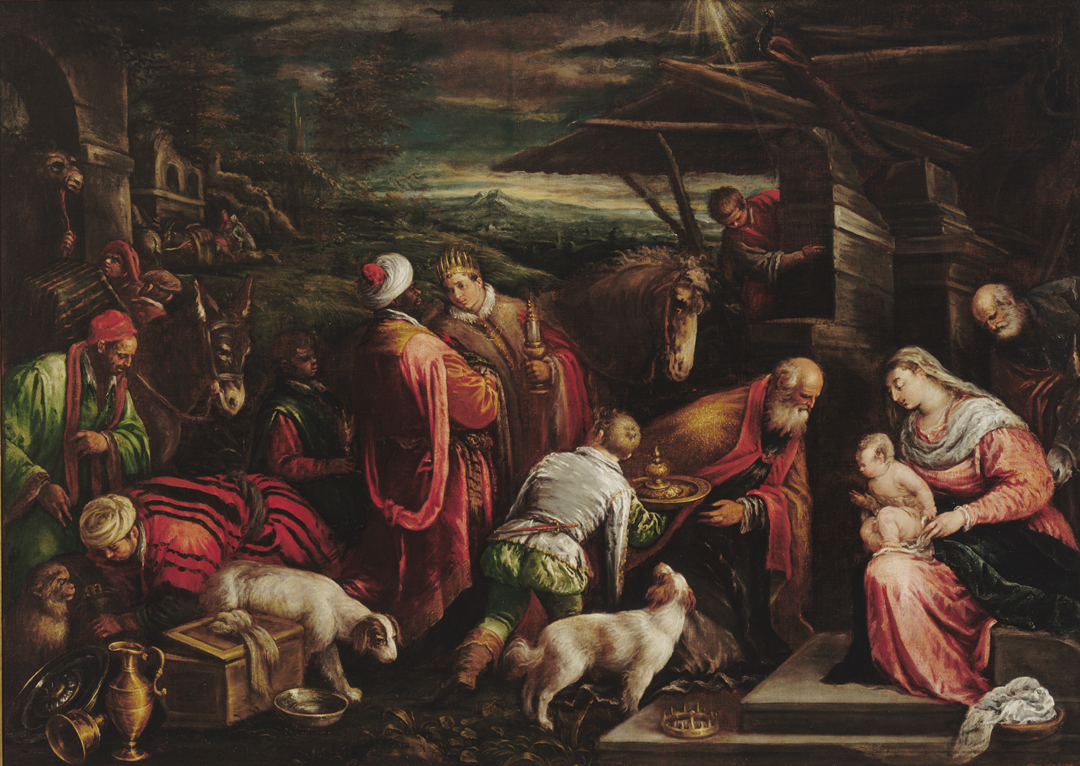Object of The Week: The Adoration of the Magi

SAM’s painting by Francesco Bassano of the Adoration of the Magi contributes to several different stories in art history: the Italian Renaissance, Venetian painting, and religious art, among others. By situating this work where it is, in our Emblems of Encounter installation, we’re encouraging folks to look at the painting through a particular lens, focusing on its inclusion of two figures with dark skin: the magus that takes a central place in the painting, and the smaller page who stands behind him.
Why are these figures here? What role do they play? What do they reveal?
By the time he painted this work, Francesco Bassano could rely on established traditions attached to the Adoration story that would tell him what symbols to include and how to compose his picture. This prominent biblical story had been referenced by countless artists over several hundred years and had become codified in European visual art. Still, it wasn’t until the years between the middle of the 14th and the middle of the 15th centuries that artists working in what is now Germany and the Czech Republic initiated the trend of depicting one magus with dark skin.¹ The motif of the African magus in visual art developed out of Medieval writings that allegorized biblical stories: scholars at that time understood the three magi, or wise men, who appear in the Book of Matthew as symbols for the three known continents—Asia, Africa, and Europe. A writer known as Pseudo-Bede would make the not unreasonable corollary that the African magus was dark-skinned.² This black magus made his arrival in Italian painting around the mid-15th century, importantly coinciding with growing interaction between Europe and Africa: trade, missionary efforts, and of course, the importing of slaves.
Similarly serving to fill the scene with visual interest and to illustrate the burgeoning diversity of the painter’s world, a group of sweetly rendered animals attends the scene. The caravan of worshippers arrives on the backs of camels, donkeys, and horses. A furry monkey surveying the scene, a pair of handsome dogs, and a regal peacock complete the menagerie. The movement of the painting, enforced by the swooping line of the caravan, leaning figures and gestures, directs our eye to the figures of the infant Jesus and mother Mary. Their whiteness is the standard against which the African magus and his page are made to look different.
Though Bassano’s painting reflects a one-sided perspective, it seems to me that it could hardly have been otherwise. The painting records a historical moment when people were interacting across cultures and across continents with more frequency than ever. The appearance of the black magus in the larger theme of the Adoration shows one people group attempting to make sense of an increasingly complex and diverse world, folding new revelations into their existing understanding of things. In such pictures, we see a European effort to “reassert order and to avoid an ontological abyss,” says historian Peter Mark. “By fitting the African into an existing Christian iconography, European artists were incorporating the Black man into their familiar view of the world.”³
– Jeffrey Carlson, SAM Collections Coordinator